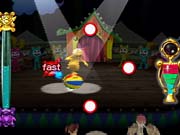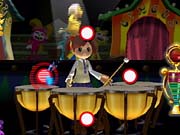Mad Maestro
Eidos offers gamers a Fresh take on music games.
Once upon a time, gamers used to marvel at the eclectic mix of titles that were released in the Japanese market and never saw the light of day in the US. However, as the industry has matured and publishers have become more adventurous, we've been lucky enough to see a few unique Japanese games make their way to the States. The music genre in particular has slowly been growing in diversity since Bust-A-Move first hit the PlayStation. Eidos Interactive will be doing its part to broaden the genre with its upcoming release Mad Maestro for the PlayStation 2. Released under the newly formed "Fresh Games" label, the game is a localized version of Bravo Music, a game that puts a new twist on the music game.

While the majority of music games have focused on contemporary music, ranging from Parappa the Rapper's hip-hop-influenced tunes to the Bust-A-Move series' dance fare, Mad Maestro heads into entirely new territory. The game focuses on a young conductor named Takt who's tapped by a fairy named Symphony to help prevent the destruction of a local concert hall. In order to gather a large enough crowd for Takt's performance, the pair head out to help assorted town denizens with the power of music. Due to Takt's profession, the tunes in the game are pieces of classical music--such as Wagner's "Flight of the Valkyries"--that are a definite departure from the more commercial fare you'd expect from a music-based video game.

While Mad Maestro's tunes may be a bit unorthodox, they actually work well within the context of the game. Rather than offer the traditional style of music game action, Mad Maestro actually serves up a different, but involving, experience that manages to be pretty addictive. As in all music games, the ultimate goal of each level is to keep up with the music, but the way you interact with the music in this game is very different. In your role as Takt, conductor extraordinaire, you're told to control three aspects of the music: the tempo, the volume, and the part of the piece being played. To do so, you'll rely on a unique control setup that will support the analog functionality of the PS2 controller's face buttons and make use of the D-pad as well. The timing between button presses will control the music's tempo, the pressure applied to the buttons will determine the music's volume, and the directional pad presses will cue the transition to the next part of the piece you're conducting. Although it may sound a bit complicated, it actually works pretty well in practice.

When playing the game, you'll see between three and four "cue points"--depending on the meter of the piece of music you're conducting--arranged in a cross shape in the center of the screen. A "cue ball" constantly moves clockwise between the points. Your goal is to press whichever face button you're comfortable with as the cue ball passes through a cue point. You'll be rewarded with audio and visual cues to let you know how good your timing is. You'll be alerted to the amount of pressure to apply by the color of the cue point--blue is soft, green is medium, and red is hard. You'll also occasionally see a directional arrow in a cue point that will require you to push the D-pad and a button at the same time. Although you should pick up a feel for the amount of pressure to apply while playing the game, an onscreen "pressure meter" will be visible onscreen to show you how hard you're pressing the buttons. The last component of your onscreen HUD is a "tension meter," which is a long horizontal bar on the left side of the screen. It will slowly fill as you match the onscreen control inputs. When the meter is full, the game will shift to "angel mode," which is denoted by a smiling angel face at the top of the screen. The key to clearing a level is to be in angel mode when the piece ends. If you can't fill up the meter, or you make too many mistakes while in angel mode, the game will shift to devil mode. While in devil mode, the tension meter won't fill and a malicious-looking purple devil head will park itself at the top of the screen. To return to angel mode, you'll have to play error-free for a short stretch.

You'll have plenty of opportunities to get the gameplay down thanks to the variety of modes in Mad Maestro. You'll find a tutorial to help you get the basics down, as well as a child mode that just requires single button presses. When you've gotten a handle on things, you can try out the game's main story mode, which features a submode called "extra fun" that offers quite a bit of variety. When playing in the story mode, you'll follow Takt and Symphony's adventures as they go through the town helping a motley crew of locals, including a troubled couple, a circus clown, a designer experiencing supermodel troubles, and a news reporter beset by aliens.
Each encounter is broken down into separate episodes you'll have to clear. Once you've completed a level, you'll be ranked for your performance and possibly unlock things to do in the extra fun mode. You'll find a free play mode that lets you to play through any level you've cleared, a replay mode that lets you view replays of your conducting, a music room that will let you listen to musical pieces you've cleared, and a bonus games mode that will offer 10 bonus games to play once you've unlocked them.

Graphically, Mad Maestro keeps things simple and cartoony. CG movies will provide the setup for each level and fade into the game's solid graphics engine. The game's suitably eccentric cast features character design from the school of big heads and lanky limbs, which fits with the game's tone. In terms of polygons, the crew may not be incredibly buffed out, but they offer enough detail for this type of game. The game's levels fare a bit better thanks to their dynamic reactions to your performance. Like in Samba de Amigo, the game's levels will change on the fly according to how you're doing. If you quickly fill your tension meter and reach angel mode, expect to see a lot of dramatic action, as the levels will begin to blossom with activity. If you lack rhythm skills and slip into devil mode, expect things to take an equally dramatic turn for the worse, as the stage you're playing on will start to fall apart and become dark. The dynamic level changes and the variety in their locations keep things visually interesting throughout the game.

The sound in Mad Maestro is as engaging as the game's graphics. Although the game features some sound effects and some slightly shaky voice acting, the eclectic mix of classical music is obviously the main draw. The tunes are capably reproduced, albeit without the benefit of a true orchestra. Fortunately, the music changes dynamically according to your playing, which keeps the pace of the game pleasantly hectic.
Overall, Mad Maestro looks like it will be a unique and addictive entry in the music game genre. Its singular gameplay sets it apart from the rest of the pack and keeps it interesting, and it may also be the first introduction to some of its classical tunes for players who may not be up on their Tchaikovsky. Gamers eager to try their hand at virtual conducting can look for the game this spring.
Got a news tip or want to contact us directly? Email news@gamespot.com
Join the conversation